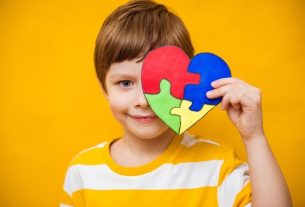The treatment of autism, despite not curing this syndrome, is capable of improving communication, concentration and reducing repetitive movements, thus improving the quality of life of the autistic person and their family.
For effective treatment, it is recommended that it be carried out with a team made up of a doctor, physiotherapist, psychotherapist, occupational therapist and speech therapist, who recommend specific therapies for each patient, and often must be carried out for life.
Furthermore, taking care of your diet and activities such as music therapy and equine therapy can also contribute greatly to improving symptoms.

Treatment options
Some important strategies for treating autism, whether in mild or severe cases, include:
1. Medicines
The main medications indicated for the treatment of autism are:
- Risperidone;
- Aripiprazol;
- Melatonin;
- Fluoxetine;
- Sertraline;
- Methylphenidate;
- Clonidine.
However, these medications are generally indicated according to the symptoms identified by the doctor, such as aggressiveness, impulsivity, inattention, difficulty dealing with frustration, anxiety, depression and sleep changes.
It is important that even with the use of medicines recommended by the doctor, other strategies are adopted that help alleviate symptoms and, thus, it is possible to reduce the dose or suspend the medicine in the future.
2. Food
The child’s diet should be varied and healthy, including fruits and vegetables, whole grains, legumes and proteins. This way it is possible to guarantee healthy growth and development and prevent situations such as constipation, nutrient deficiency or obesity. See what nutrition should be like in autism.
As it is common for children with autism spectrum disorder to refuse some foods, it is important to adopt some measures, such as making creative presentations with dishes, creating menus or offering food options for the child to choose from. These strategies can make the child more comfortable, improving food acceptance.
3. Speech therapy
Follow-up with a speech therapist is important to improve verbal communication between children on the autistic spectrum and other people. During the sessions, various exercises are carried out that can help the child increase their vocabulary and improve their voice intonation, and games and games can be played to attract the child’s attention.
4. Music therapy
Music helps children understand emotions, increasing their interaction with the world around them. The objective is not to learn to sing or play any instrument, it is just important to know how to listen and express yourself through the sounds that instruments can produce and also through dance movements, for example, in a light and relaxed environment.
5. Psychotherapy
Psychotherapy must be guided by a psychologist and can be carried out alone or in a group, with weekly meetings. Especially through behavioral therapy, it is possible to develop communication and interaction skills, as well as strategies for dealing with emotional difficulties.
6. Occupational therapy
Occupational therapy is also indicated in the treatment of autism spectrum disorder, and is often indicated in association with psychotherapy. The objective of occupational therapy is to improve the person’s quality of life and stimulate autonomy, which is done through technologies and activities that require the person’s action, as well as activities that promote the person’s adaptation process to society and self-confidence. .
8. Psychomotricity
It can be guided by a specialist physiotherapist and, during the sessions, various games and games can be played with the aim of developing motor coordination and movement control.
9. ABA Therapy
ABA therapy is a method that helps with social, communicative and emotional skills and learning, improving the quality of life and autonomy of people with autism spectrum disorder, who have difficulties in socializing, learning or in daily activities, such as nutrition and self-care.
Read too: ABA therapy: what it is, what it is for and how it is done
10. Hippotherapy
Horse therapy is very useful for improving the body’s righting reaction when the child is on top of the animal, motor coordination, breathing control and developing the autistic person’s self-confidence. Sessions generally last between 30 minutes and 1 hour. Find out more about equine therapy.
Which doctor to consult
The doctor who usually initiates the diagnosis of autism is a pediatrician, however, other professionals such as a clinical psychiatrist or pediatric neurologist are generally needed to analyze and guide the best forms of treatment.
Taking care of your health has never been easier!
How to care for an autistic child at home
Some important precautions that should be taken at home, to improve the quality of life of children with autism spectrum, are:
- Observe whether the child has greater ease with a certain task, because many autistic people have an aptitude for mathematics, music, drawing or computers, for example;
- Respect routines, as autistic people do not tolerate changes well;
- Avoid having unnecessary furniture and objects at home, to protect them from accidents;
- Develop good sleep habits, respecting bedtime, with less intense lights and light meals before going to bed.
Another important tip is to avoid places such as cafeterias and supermarkets, as there are many stimuli in these places, such as very bright lights and a lot of noise, which can cause discomfort in the child.
Bibliography
- AUTISM SPEAKS. Applied Behavior Analysis (ABA). Available at: <https://www.autismspeaks.org/applied-behavior-analysis>. Accessed on March 12, 2024
- AISHWORIYA, Ramkumar et al. An Update on Psychopharmacological Treatment of Autism Spectrum Disorder. Neurotherapeutics. Vol.19. 248–262, 2022
- STATPEARLS. Autism Spectrum Disorder. 2022. Available at: <https://www.ncbi.nlm.nih.gov/books/NBK525976/>. Accessed on March 2, 2023
- CREFITO. The role of the Occupational Therapist in the treatment of Autism. Available at: <https://www.crefito9.org.br/imprime.php?cid=1064&sid=320>. Accessed on Feb 11, 2022
- BRAZILIAN SOCIETY OF PEDIATRICS. Autism Spectrum Disorder. 2019. Available at: <https://www.sbp.com.br/fileadmin/user_upload/21775c-MO_-_Transtorno_do_Espectro_do_Autismo.pdf>. Accessed on April 28, 2021
- MONTEIRO, Manuela A.; SANTOS, Andressa A.; GOMES, Lidiane MM; FONSECA, Rosane Valéria V. Autism spectrum disorder: a systematic review of nutritional interventions. Rev Paul Pediatr. Vl 38. 2020




